HONDA CR-V 2010 RD1-RD5, RE7 / 3.G Repair Manual
Manufacturer: HONDA, Model Year: 2010, Model line: CR-V, Model: HONDA CR-V 2010 RD1-RD5, RE7 / 3.GPages: 441, PDF Size: 8.12 MB
Page 61 of 441
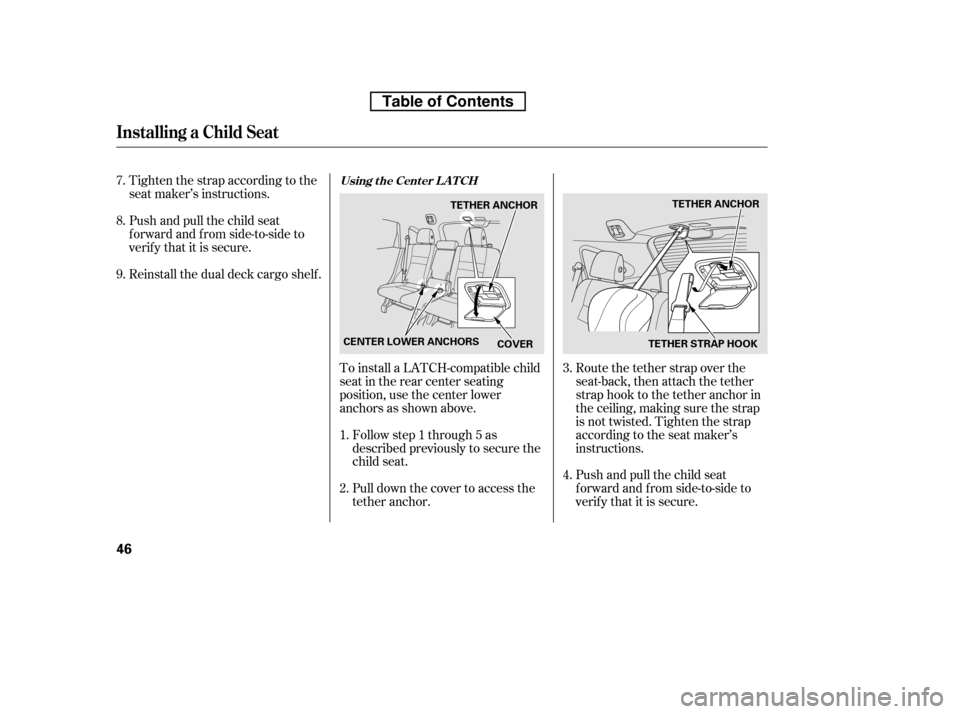
Follow step 1 through 5 as
described previously to secure the
child seat.
Pull down the cover to access the
tether anchor.Route the tether strap over the
seat-back, then attach the tether
strap hook to the tether anchor in
the ceiling, making sure the strap
is not twisted. Tighten the strap
according to the seat maker’s
instructions.
To install a LATCH-compatible child
seat in the rear center seating
position, use the center lower
anchorsasshownabove.
Push and pull the child seat
f orward and f rom side-to-side to
verif y that it is secure.
Tighten the strap according to the
seat maker’s instructions.
Push and pull the child seat
f orward and f rom side-to-side to
verif y that it is secure.
Reinstall the dual deck cargo shelf .
1. 2. 3. 4.
8. 9.
7.
Using t he Cent er L A T CH
Installing a Child Seat
46
TETHER STRAP HOOK
TETHER ANCHOR
CENTER LOWER ANCHORS COVER TETHER ANCHOR
Table of Contents
Page 62 of 441

When not using the LATCH system,
all child seats must be secured to the
vehicle with the lap part of a lap/
shoulder belt.With the child seat in the desired
seating position, route the belt
through the child seat according
to the seat maker’s instructions,
then insert the latch plate into the
buckle and remove any slack f rom
the lap portion of the belt.To activate the lockable retractor,
slowly pull the shoulder part of the
belt all the way out until it stops,
then let the belt f eed back into the
retractor.
Af ter the belt has retracted, tug on
it. If the belt is locked, you will not
be able to pull it out. If you can pull
thebeltout,itisnotlocked,and
you will need to repeat these steps.
In addition, the lap/shoulder belts in
all seating positions except the
driver’s have a lockable retractor
that must be activated to secure a
child seat.
If you intend to install a child seat in
the center seating position of the
rear seat, make sure the detachable
seat belt anchor is securely latched
(see page ).
2.
1.
3.
109
CONT INUED
Installing a Child Seat with a L ap/
Shoulder Belt
Installing a Child Seat
Driver and Passenger Saf ety
47
Table of Contents
Page 63 of 441
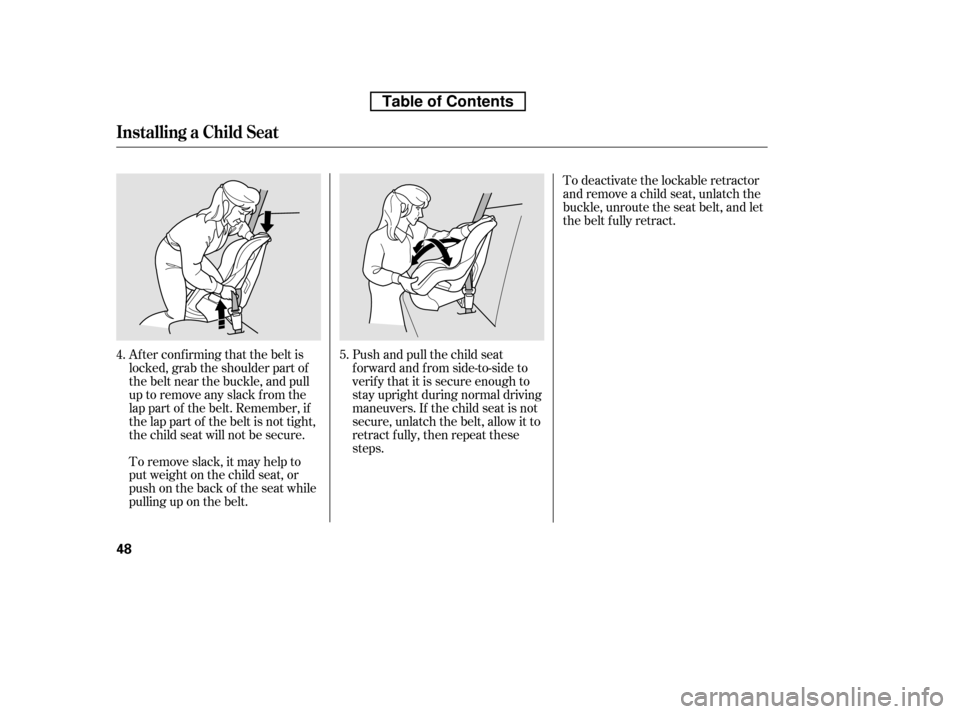
Af ter conf irming that the belt is
locked, grab the shoulder part of
the belt near the buckle, and pull
up to remove any slack from the
lap part of the belt. Remember, if
the lap part of the belt is not tight,
the child seat will not be secure.Push and pull the child seat
f orward and f rom side-to-side to
verif y that it is secure enough to
stay upright during normal driving
maneuvers. If the child seat is not
secure, unlatch the belt, allow it to
retract f ully, then repeat these
steps.To deactivate the lockable retractor
and remove a child seat, unlatch the
buckle, unroute the seat belt, and let
the belt fully retract.
To remove slack, it may help to
putweightonthechildseat,or
push on the back of the seat while
pulling up on the belt.
4.
5.
Installing a Child Seat
48
Table of Contents
Page 64 of 441
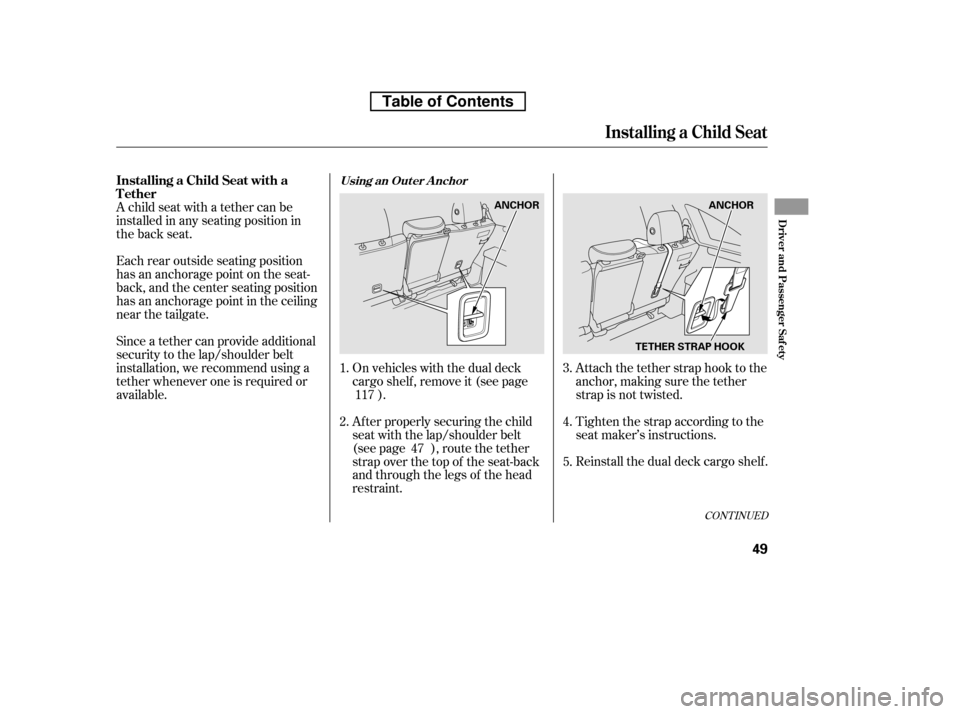
A child seat with a tether can be
installed in any seating position in
the back seat.
Each rear outside seating position
has an anchorage point on the seat-
back, and the center seating position
has an anchorage point in the ceiling
near the tailgate.
Since a tether can provide additional
security to the lap/shoulder belt
installation, we recommend using a
tether whenever one is required or
available.Attach the tether strap hook to the
anchor, making sure the tether
strap is not twisted.
Tighten the strap according to the
seat maker’s instructions.
Reinstall the dual deck cargo shelf .
On vehicles with the dual deck
cargoshelf,removeit(seepage
).
Af ter properly securing the child
seat with the lap/shoulder belt
(see page ), route the tether
strap over the top of the seat-back
and through the legs of the head
restraint.
1.
3.
2. 4. 5.
117
47
CONT INUED
Installing a Child Seat with a
TetherUsing an Out er A nchor
Installing a Child Seat
Driver and Passenger Saf ety
49
TETHER STRAP HOOK ANCHOR
ANCHOR
Table of Contents
Page 65 of 441
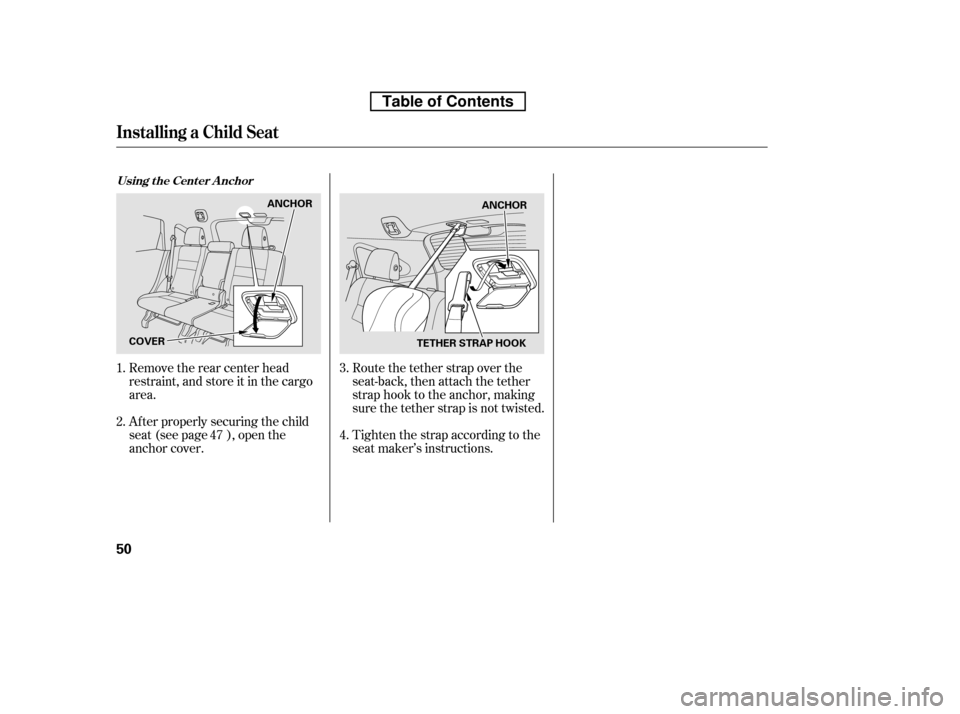
Route the tether strap over the
seat-back, then attach the tether
strap hook to the anchor, making
sure the tether strap is not twisted.
Tighten the strap according to the
seat maker’s instructions.
Af ter properly securing the child
seat (see page ), open the
anchor cover.
Remove the rear center head
restraint, and store it in the cargo
area.
1. 2. 3. 4.
47
Using t he Cent er A nchor
Installing a Child Seat
50
TETHER STRAP HOOK
COVER ANCHOR
ANCHOR
Table of Contents
Page 66 of 441

When a child reaches the
recommended weight or height limit
for a forward-facing child seat, the
child should sit in a back seat on a
booster seat and wear the lap/
shoulder belt.
The f ollowing pages give
instructions on how to check proper
seat belt f it, what kind of booster
seat to use if one is needed, and
important precautions f or a child
who must sit in f ront.To determine if a lap/shoulder belt
properly f its a child, have the child
put on the seat belt, then ask
yourself :Does the child sit all the way back
against the seat?
Do the child’s knees bend
comf ortably over the edge of the
seat?
1. 2.
CONT INUED
Checking Seat Belt Fit
Protecting L arger Children
Driver and Passenger Saf ety
51
Allowing a child age 12 or under
to sit in front can result in injury
or death if the passenger’s front
airbag inflates.
If a child must ride in front,
move the vehicle seat as far
back as possible, use a booster
seat if needed, have the child
sit up properly and wear the
seat belt properly.
Table of Contents
Page 67 of 441
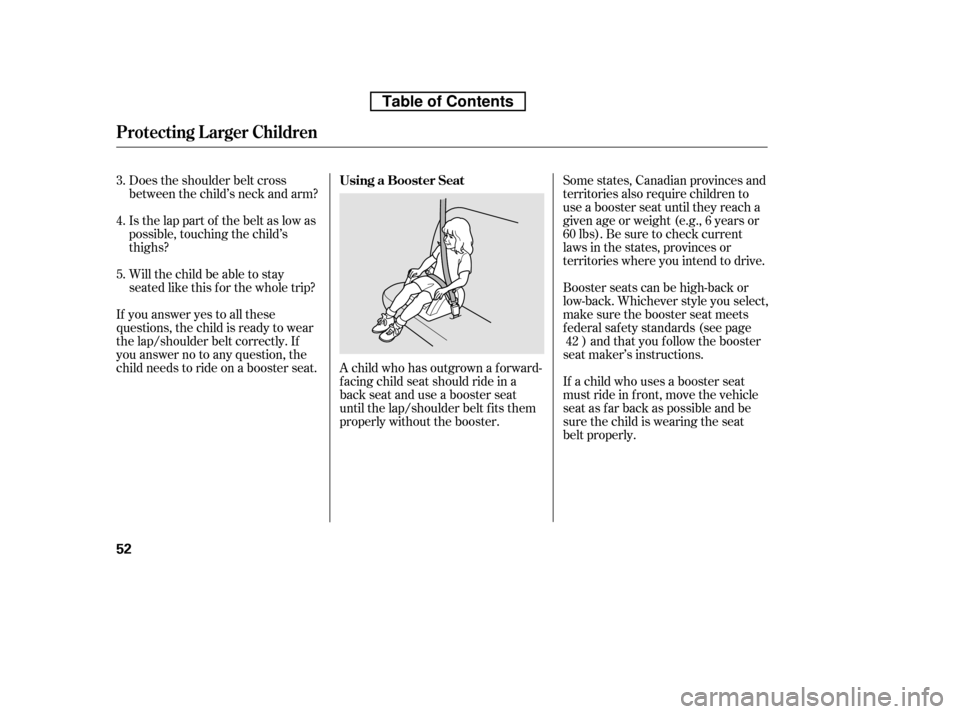
Does the shoulder belt cross
between the child’s neck and arm?
Is the lap part of the belt as low as
possible, touching the child’s
thighs?
Will the child be able to stay
seated like this f or the whole trip?
If you answer yes to all these
questions, the child is ready to wear
the lap/shoulder belt correctly. If
you answer no to any question, the
child needs to ride on a booster seat. A child who has outgrown a f orward- f acing child seat should ride in a
back seat and use a booster seat
until the lap/shoulder belt f its them
properly without the booster.Booster seats can be high-back or
low-back. Whichever style you select,
make sure the booster seat meets
f ederal saf ety standards (see page
) and that you f ollow the booster
seat maker’s instructions.
If a child who uses a booster seat
must ride in f ront, move the vehicle
seat as far back as possible and be
sure the child is wearing the seat
belt properly.
Some states, Canadian provinces and
territories also require children to
use a booster seat until they reach a
given age or weight (e.g., 6 years or
60lbs).Besuretocheckcurrent
laws in the states, provinces or
territories where you intend to drive.
3. 4. 5.
42
Using a Booster Seat
Protecting L arger Children
52
Table of Contents
Page 68 of 441
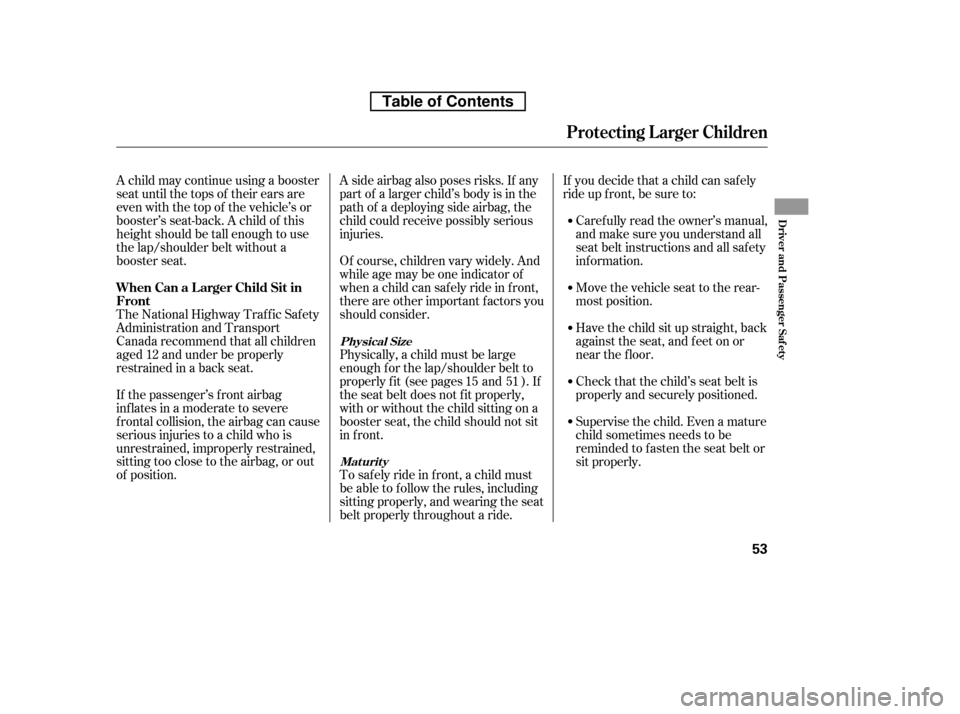
A child may continue using a booster
seat until the tops of their ears are
even with the top of the vehicle’s or
booster’s seat-back. A child of this
height should be tall enough to use
the lap/shoulder belt without a
booster seat.
The National Highway Traffic Safety
Administration and Transport
Canada recommend that all children
aged 12 and under be properly
restrained in a back seat.
If the passenger’s f ront airbag
inf lates in a moderate to severe
f rontal collision, the airbag can cause
serious injuries to a child who is
unrestrained, improperly restrained,
sitting too close to the airbag, or out
of position.A side airbag also poses risks. If any
part of a larger child’s body is in the
path of a deploying side airbag, the
child could receive possibly serious
injuries.
Of course, children vary widely. And
while age may be one indicator of
when a child can saf ely ride in f ront,
there are other important f actors you
should consider.
Physically, a child must be large
enough f or the lap/shoulder belt to
properly f it (see pages and ). If
the seat belt does not f it properly,
with or without the child sitting on a
booster seat, the child should not sit
in f ront.
To saf ely ride in f ront, a child must
be able to f ollow the rules, including
sitting properly, and wearing the seat
belt properly throughout a ride.If you decide that a child can saf ely
ride up f ront, be sure to:
Caref ully read the owner’s manual,
and make sure you understand all
seat belt instructions and all saf ety
inf ormation.
Move the vehicle seat to the rear-
most position.
Have the child sit up straight, back
against the seat, and feet on or
near the f loor.
Check that the child’s seat belt is
properly and securely positioned.
Supervise the child. Even a mature
child sometimes needs to be
reminded to f asten the seat belt or
sit properly.
15 51
When Can a L arger Child Sit in
Front
Physical Size
Maturity
Protecting L arger Children
Driver and Passenger Saf ety
53
Table of Contents
Page 69 of 441
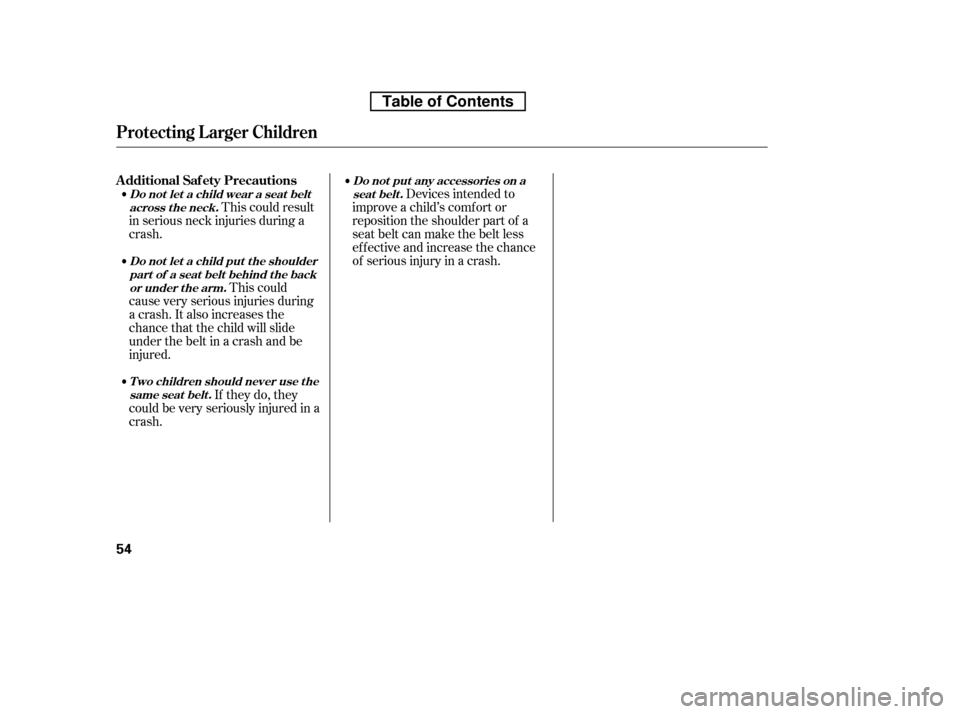
This could result
in serious neck injuries during a
crash.
This could
cause very serious injuries during
a crash. It also increases the
chance that the child will slide
under the belt in a crash and be
injured.
If they do, they
could be very seriously injured in a
crash. Devices intended to
improve a child’s comf ort or
reposition the shoulder part of a
seat belt can make the belt less
ef f ective and increase the chance
of serious injury in a crash.
Additional Saf ety Precautions
Do not let a child wear a seat belt
across t he neck.
Do not let a child put the shoulderpart of a seat belt behind t he backor under t he arm.
T wo children should never use t hesame seat belt . Do not put any accessories on a
seat belt .
Protecting L arger Children
54
Table of Contents
Page 70 of 441
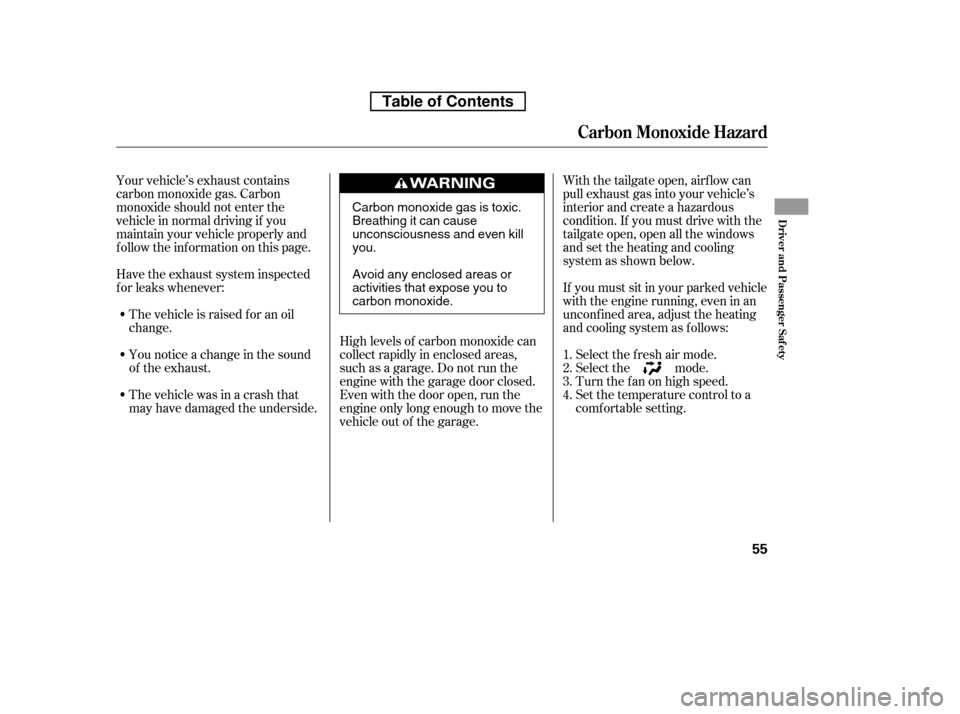
Your vehicle’s exhaust contains
carbon monoxide gas. Carbon
monoxide should not enter the
vehicle in normal driving if you
maintain your vehicle properly and
f ollow the inf ormation on this page.
Have the exhaust system inspected
f or leaks whenever:High levels of carbon monoxide can
collect rapidly in enclosed areas,
such as a garage. Do not run the
engine with the garage door closed.
Even with the door open, run the
engine only long enough to move the
vehicle out of the garage.
The vehicle is raised f or an oil
change.
You notice a change in the sound
of the exhaust.
The vehicle was in a crash that
may have damaged the underside. With the tailgate open, airflow can
pull exhaust gas into your vehicle’s
interior and create a hazardous
condition. If you must drive with the
tailgate open, open all the windows
and set the heating and cooling
system as shown below.
If you must sit in your parked vehicle
with the engine running, even in an
unconf ined area, adjust the heating
and cooling system as f ollows:
Select the f resh air mode.
Select the mode.
Turn the f an on high speed.
Set the temperature control to a
comfortable setting.
1.2.3.4.
Carbon Monoxide Hazard
Driver and Passenger Saf ety
55
Carbon monoxide gas is toxic.
Breathing it can cause
unconsciousness and even killyou.
Avoid any enclosed areas or
activities that expose you to
carbon monoxide.
Table of Contents